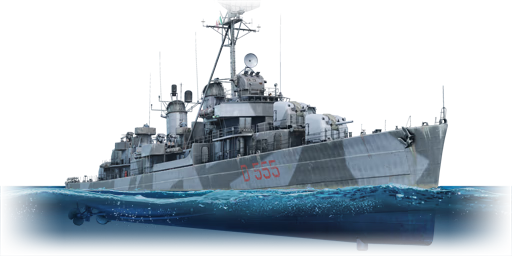



After World War II, Italy's navy had been cut in half, and heavily restricted in terms of armaments. Only from the 1950s onward was it allowed to begin reconstruction, due to Italy's entry into NATO. Over the years, several ships were built, but at the same time tensions between NATO and the Warsaw Pact increased and so in the 1970s Italy asked the United States for destroyers to replace the old Benson-class destroyers. Three Fletcher-class ships were delivered, later renamed Fante (D 561), Geniere (D 555), and Lanciere (D 560). The Geniere (D 555) in Italian service participated in training missions, coastal control, and other minor missiosn, but never saw combat. After 5 years, the ship was replaced by more modern units and was eventually scrapped in 1975.
Introduced in Update "Danger Zone", Geniere is a fairly good premium ship thanks to its armament composed of four single 127 mm guns with good reload thanks to the autoloader. Thanks to the powerful SAP shells, you will be able to ammo rack enemy ships very easily, and their HE-VT shells are perfect to shoot down other targets, including aircraft. In conjunction with the three twin 76 mm emplacements, also able to be equipped with HE-VT shells, Geniere can quickly cause damage enemy aircraft and boats alike. The 6 anti-submarine torpedoes cause little damage to large ships, but they may disable important modules, allowing you to take the opportunity to finish them off with the main guns. The manoeuvrability and speed are quite good. This ship is perfect for those who want to have a different play style from the Italian WWII destroyers.
| Ammunition | Type | Armor penetration (mm) at a distance: | |||||
|---|---|---|---|---|---|---|---|
| 1000 m | 2500 m | 5000 m | 7500 m | 10000 m | 15000 m | ||
| HE | 36 | 36 | 36 | 36 | 36 | 36 | |
| Common | 119 | 94 | 64 | 44 | 32 | 28 | |
| SP Common | 146 | 116 | 79 | 55 | 41 | 34 | |
| HE-VT | 36 | 36 | 36 | 36 | 36 | 36 | |
| Ammunition | Type | Armor penetration (mm) at a distance: | |||||
|---|---|---|---|---|---|---|---|
| 100 m | 1000 m | 2000 m | 3000 m | 4000 m | 5000 m | ||
| HE | 11 | 10 | 8 | 8 | 8 | 8 | |
| HE-VT | 12 | 10 | 9 | 8 | 7 | 7 | |
48 × Mk.10 "Hedgehog" mortar






 2 x (165 / 380) %
2 x (165 / 380) % 
 2 x 130 %
2 x 130 % 

Seakeeping |
|---|
Unsinkability | |
|---|---|
Firepower | ||
|---|---|---|